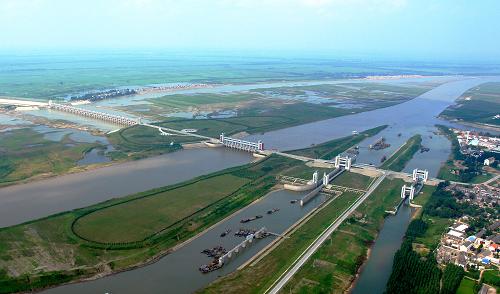Starting from central China’s Henan Province into the Yangtze River, Huaihe River has a special title: the most difficult river to manage in China.

Huaihe River (File photo)
While many rivers in China experienced severe floods this summer, no one was injured or killed in the Huaihe River Basin, and no major dangerous cases occurred at the main dams. More than half a century has passed, and the most difficult river in China has changed.
But since the founding of the People’s Republic of China, dozens of severe floods have been occurring there.
The location and climate of Huaihe River generally determines the frequency of disasters. With a total length of over 1,000 kilometers, the river flows through the transitional region between China’s northern and southern climate, where weather is complex and unpredictable. Because of the small river drop of a minimum of 6 meters, the discharge of Huaihe River in the middle and lower reaches is very slow. The dense population in the Huaihe River Basin is another factor that influences the discharge capacity.
As one of China’s major waterways, Huaihe River flows through one-ninth of China’s population, a tenth of the cultivated land, and contributes one-sixth of the country’s grain output and one-fourth of its commodity grain.
In October 1950, the Chinese central government promulgated “Decisions on the management of Huaihe River” followed by twelve Cabinet meetings on this issue. After the founding of the People’s Republic of China, Huaihe River became the first major river to be systematically and comprehensively harnessed.
Over the past 70 years, remarkable results have been achieved in the management of Huaihe River, with a more complete flood control system and improved disaster-preventing ability.
In late July this year, at the intersection of the upper and lower reaches of the Huaihe River, the Wangjiaba floodgate, known as the “largest floodgate on Huaihe River”, discharged water into the Mengwa flood storage area after 13 years.
The Mengwa flood storage area can not only reduce the flood control pressure on the upstream and downstream, but also effectively reduce the water level in the downstream river channel through active water intake. During the three-day storage period in July this year, a total of 375 million cubic meters of flood storage was accumulated.
Both the Wangjiaba floodgate and Mengwa flood storage area were important projects for the treatment of the Huaihe River, having played important roles in flood seasons more than ten times.
Reservoirs have also been built on the upper reaches of the Huaihe River. At present, more than 6,300 reservoirs have been built in the Huaihe River Basin, with a total storage capacity of 32.9 billion cubic meters.
By the end of the 20th century, China had started the construction of the Huaihe River channel to the sea in the lower reaches of Jiangsu Province. Through decades of hard work, the Huaihe River, which has not entered the sea for more than 800 years, finally embraces it.
Intelligent monitoring, command, and decision-making systems are also being improved. The hydrological information of pivotal control stations in the basin is reported every 6 minutes, providing a basis for scientific operations.
Moving residents out of the dangerous areas is also a major achievement in the Huaihe River Basin over the years.
Since 2003, residents in flood storage areas and beaches in Anhui, Jiangsu and other places along the Huaihe River have been relocated. More than 870,000 people in waterlogged areas have been gradually moved to safe areas, and rekindled the ecological function.
Over the past 70 years, the total investment in the five rounds of Huaihe River management has been more than 900 billion yuan ($135 billion), and the direct economic benefits have reached 4.7 trillion yuan. This river, once the hardest one to manage, has become a picturesque one to visit.
(Compiled by An Bowen)


